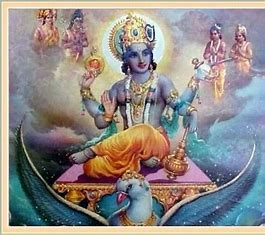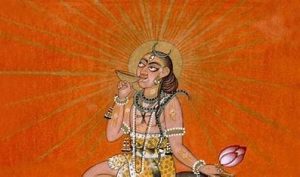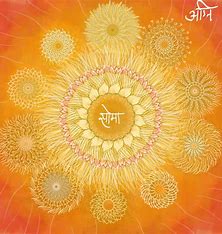Soma, as understood in the Vedic and yogic traditions, has a deeply symbolic and experiential relationship with the psyche — that is, our mind, emotions, and inner consciousness. Although it begins as a mythological elixir and ritual substance, Soma evolves into a profound psychological principle that shapes our experience of bliss, beauty, healing, and self-integration. They are references to Soma as a concept in the Rigveda (as a Devata), and the Upanishads (Chandogya, Brihadaranyaka and Taittiriya) and many other contemporary and modern texts in the Tantras and Kundalini Yoga.
consciousness. Although it begins as a mythological elixir and ritual substance, Soma evolves into a profound psychological principle that shapes our experience of bliss, beauty, healing, and self-integration. They are references to Soma as a concept in the Rigveda (as a Devata), and the Upanishads (Chandogya, Brihadaranyaka and Taittiriya) and many other contemporary and modern texts in the Tantras and Kundalini Yoga.
It has a direct influence on our subtle body and mind, through the inner experiences of emotional nourishment, peace, joy, harmony and contentment. From this direct action, it can be said that its functions and characteristics are somehow opposite to Agni, defined as fire, energy, will, and courage and the one that ignites our mind and body (eg, Related to anger, grief, and fear).
In Tantra and yoga, Soma is understood as a subtle energy of bliss that is achieved through states of meditation, joy, and love. It is related to the pineal gland and the Sahasrara chakra (Crown), nourishing the subtle body. It can be strengthened by inner meditation and restraint, pranayama, or even brahmacharya (celibacy). These characteristics are heavily related to the direct work with the mind (manas) and intellect (Buddhi) to some extent.
The psychological qualities of Soma are connected with a sense of joy and ecstasy, inner peace and equanimity, subtle emotional contentment, and a cooling effect on the heat of mental overactivity or emotional turbulence. In this sense, it is a perfect tool to foster and consider when working with clients with different affections to the mind, such as depression or anxiety (including burnout).
 In some of the modern interpretations of Soma as a psychological principle, such as in Sri Aurobindo’s Integral Yoga, Soma is understood as the bliss aspect of consciousness (Ananda) as in Sat-Chit-Ananda. It is the sense of delight that is experienced in the moment of realisation of the Self as Atman, and it manifests as inner joy, beauty, aesthetic appreciation (for all arts), and creative inspiration.
In some of the modern interpretations of Soma as a psychological principle, such as in Sri Aurobindo’s Integral Yoga, Soma is understood as the bliss aspect of consciousness (Ananda) as in Sat-Chit-Ananda. It is the sense of delight that is experienced in the moment of realisation of the Self as Atman, and it manifests as inner joy, beauty, aesthetic appreciation (for all arts), and creative inspiration.
On a physical level, Soma affects the different doshas (physically and psychologically), soothing excess anxiety in Vata; cooling anger and overreactive ambition in Pitta and dissolving the emotional hardness in Kapha.
It is also important to consider that Soma is represented in the different mental and psychological states of the mind. On an emotional level, it brings a sense of bliss, serenity, and aesthetic appreciation, which brings clarity; on a mental level, it offers soft focus and intuitive perception. On a spiritual level, it shows us the state of Ananda or divine grace, bringing us balance, counterbalancing the effect of Agni in the mind, and ultimately promoting a sense of inner fulfilment, contentment, and self-realisation.
As exposed, it is an excellent tool for psychological intervention, also when working with trauma, helping to integrate traumatic events gently and allowing the nervous system to feel soothed and calm, which contributes to the sense of safety needed when working with clients with trauma and what will prevent the state of re-traumatisation. When working with belief systems and limiting beliefs, Soma helps the client to dissolve those rigid ego structures, promoting self-acceptance and self-containment.
While an extraordinary tool in a psychological context, it is also important to address the negative impact of an imbalanced Soma on the psyche and its overall influence on the mind, emotions, and body. When our Soma is depleted, we may experience a lack of inspiration, difficulty feeling love or connecting with others (apathy and emotional flatness), insomnia and dryness, blocked creativity, or even a lack of spiritual devotion. Conversely, if we encounter an excess of Soma, our minds may feel foggy, we might tend to escape or avoid discomfort, experience overattachment, lethargy, and heaviness, or even resort to emotional eating; this suggests procrastination and a lack of willpower. Additionally, imbalances in Soma have been linked to substance misuse, whereby individuals may consume substances to counteract feelings of apathy or to promote escapism, thus avoiding the effects of excess Soma.
Hari om tat sat. 